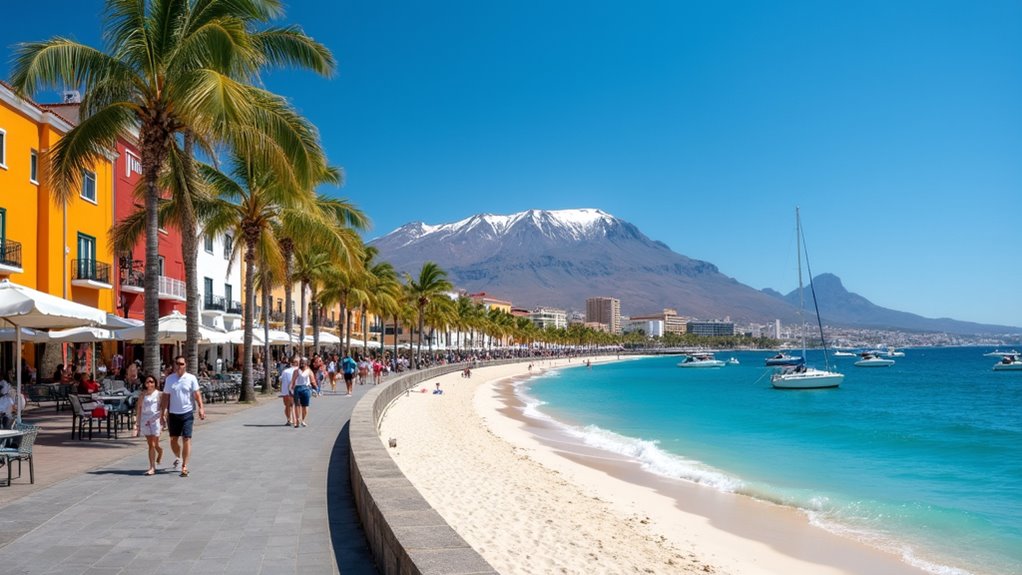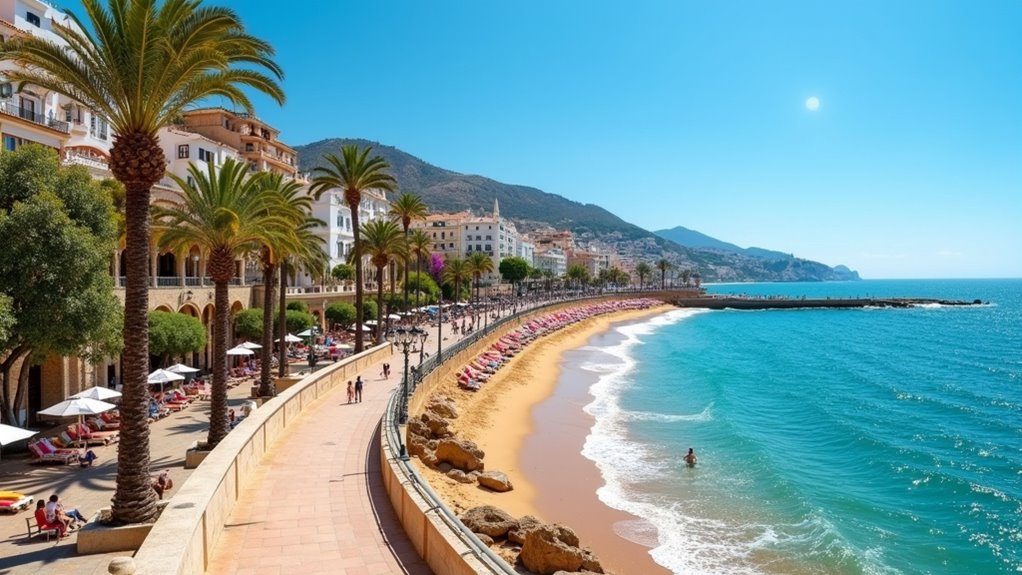Physical Address
304 North Cardinal St.
Dorchester Center, MA 02124
Physical Address
304 North Cardinal St.
Dorchester Center, MA 02124

Intrigued by Spain's scorching cities? Discover seven sizzling destinations where the sun reigns supreme and winter feels like a distant memory.
Spain’s warmest cities include Seville, Cordoba, Santa Cruz de Tenerife, Almería, Montoro, Granadilla de Abona, and Malaga. You’ll find scorching summers in Seville and Cordoba where temperatures regularly exceed 40°C, while coastal Malaga offers a milder Mediterranean-subtropical climate with 300 sunny days yearly. The Canary Islands locations maintain pleasant temperatures year-round. These sun-drenched destinations deliver everything from desert landscapes to beach paradises for your warm-weather escape.

Why do travelers often call Seville the hottest city in Spain? The numbers tell the story. With summer temperatures regularly soaring above 40°C (104°F) and an annual average of 18.8°C (65.8°F), you’ll feel the heat in this Andalusian gem.
Known as Spain’s furnace, Seville scorches visitors with 40°C summers that define this sun-drenched Andalusian capital.
August is the warmest month, averaging a sweltering 28.5°C (83°F), though July matches its intensity. Seville’s record high reached a blistering 46.6°C in 1995, making it one of Europe’s hottest cities. If you’re not a fan of sweating through your clothes, visit during spring or autumn when the weather’s delightfully mild.
Winter works too, with January’s gentle 11°C (52°F) average.
Don’t worry about rain spoiling your plans—Seville stays mostly dry, especially in summer. With up to 12 hours of sunshine in July, you’ll have plenty of time to explore the city’s affluent cultural treasures, even during the hottest months. It’s no wonder Seville ranks among the sun-soaked destinations that attract heat-seeking travelers across Europe.
While Seville often grabs headlines for its heat, Cordoba functions as Spain’s true thermal champion with summer temperatures regularly climbing above 105°F (40.5°C). You’ll find July and August particularly brutal, averaging 98°F with 12 hours of sunshine and extreme UV levels.
Unlike coastal areas, Cordoba’s inland location and mountain shelter create sharper temperature swings. During the hot season, which lasts nearly 2.9 months long, temperatures consistently soar above 90°F from mid-June through early September. Winter nights can dip to freezing, though days remain mild.
The city’s ancient architecture – thick walls and cool patios – reflects centuries of adaptation to these extremes. Many travelers researching Mediterranean destinations often compare Spain’s climate to Cypriot resorts when planning summer getaways.
If you’re visiting in summer, plan activities for mornings or evenings and stay hydrated. The trade-off? You’ll enjoy 3,000+ hours of annual sunshine and invigoratingly dry heat compared to Spain’s humid coastal regions.

Santa Cruz de Tenerife offers a completely different kind of Spanish warmth than mainland hotspots like Cordoba. This Canary Islands capital boasts a subtropical desert climate with remarkably stable temperatures year-round.
You’ll enjoy mild winters rarely dropping below 15°C and pleasant summers averaging 25-29°C.
What makes Santa Cruz’s climate special:
The city experiences its highest humidity levels of 79% in August, adding a tropical feel to the summer atmosphere.
While enjoying the pleasant climate, remember that Santa Cruz offers travel costs that are generally moderate compared to mainland Spain.
Pack light clothing year-round, but bring a windbreaker for those trade winds. For cooler escapes during hot days, head to the inland hills where temperatures drop noticeably.
Located at Europe’s driest corner, Almería boasts the continent’s only true desert climate while sitting right on the Mediterranean coast. You’ll experience over 320 sunny days annually with temperatures remaining comfortably warm even during winter months, with daytime averages around 17-18°C.
The city’s unique position near the Tabernas Desert and surrounded by protective mountain ranges creates a rain shadow effect, resulting in less than 200mm of rainfall yearly. This remarkable climate has shaped both the landscape and lifestyle.
While exploring, don’t miss Cabo de Gata-Níjar Natural Park with its otherworldly desert scenery and pristine beaches. Despite water scarcity, you’ll be amazed by Almería’s agricultural innovation through greenhouse farming.
The abundant sunshine that parches the land also makes it perfect for solar energy production and year-round tourism.

If Almería represents Spain’s desert climate by the sea, then Montoro functions as the nation’s furnace. This small town in Córdoba province has earned its fiery reputation by shattering temperature records twice in recent years, hitting an astounding 47.4°C in August 2021.
You’ll find Montoro nestled along the Guadalquivir River, where the Mediterranean climate creates ideal conditions for:
Montoro’s riverside location delivers the perfect Mediterranean extremes—punishing summers balanced by gentle winters.
Despite these challenging conditions, locals have adapted their infrastructure, water management systems, and daily routines to cope with living in Spain’s hottest spot. In July 2017, Montoro experienced another extreme heatwave when temperatures soared to 47.3°C, further cementing its status as one of Spain’s hottest locations. Much like Istanbul’s allure, Montoro’s extreme climate contributes to its unique character and makes it a fascinating, if scorching, destination.
While mainland Spain bakes in summer heat, Granadilla de Abona offers something truly special – a perfect climate year-round. This southern Tenerife gem maintains a pleasant 18.3°C average temperature with minimal rainfall (just 379mm annually). Unlike the more famous Algarve region, Granadilla provides a less crowded alternative with similarly stunning coastal beauty.
You’ll enjoy the most sunshine in July when skies are clearest, while August delivers ideal beach weather with temperatures between 23-24°C. The warm season stretches approximately 2.9 months from July to October with daily highs above 74°F. Even January stays comfortably warm at 18-22°C.
What makes Granadilla so special? It’s nestled in a protected southern location, shielded from trade winds that affect northern Tenerife. The persistent sea breezes keep humidity in check despite the coastal setting.
For the best visit, come January-February for mild exploration weather or July-October when beach conditions are perfect.

Malaga shines as one of Europe’s warmest coastal destinations, boasting an impressive 17.6°C average annual temperature and roughly 300 sunny days each year. You’ll enjoy the Mediterranean-subtropical climate that keeps winters mild and summers delightfully hot.
The city’s unique geography works in your favor:
August stands out as the hottest month with 87°F highs and pleasantly warm evenings.
Don’t worry about packing heavy coats – Malaga rarely dips below 13°C at night, and snow hasn’t been recorded since 1954! While Spain offers many attractions, Malaga is definitely worth visiting for travelers seeking a warm escape from colder European destinations.
Spain’s hottest cities aren’t just scorchers on paper—they’re like standing in front of a blast furnace with no off switch! Whether you’re soaking up Seville’s 100-degree summers or enjoying Tenerife’s year-round warmth, you’ll find your perfect heat haven. Pack light, drink plenty, and don’t forget your sunscreen. When the mercury rises, these seven spots deliver sunshine in spades, y’all.